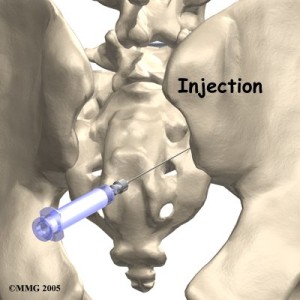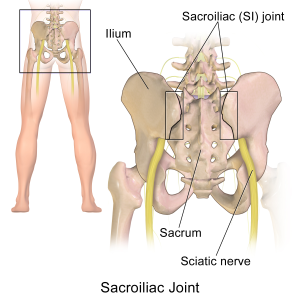What is a Sacroiliac Joint Injection?
A sacroiliac joint steroid injection is primarily used either to diagnose or treat low back pain. As well as sciatica symptoms associated with sacroiliac joint dysfunction. This injection is also called a sacroiliac joint block.
The sacroiliac joints lie next to the spine and connect the sacrum with the hip on both sides. There are two sacroiliac joints, one on the right and one on the left. Joint inflammation and/or dysfunction in this area can cause pain.
The purpose of a sacroiliac joint steroid injection is two-fold: to diagnose the source of a patient’s pain, and to provide therapeutic pain relief. At times, these are separated and a patient will undergo a purely diagnostic or therapeutic injection. Although often the two are combined into one injection.
Diagnosis
A diagnostic SI joint injection is used to confirm a suspected diagnosis of sacroiliac joint dysfunction. This is done by numbing the sacroiliac joint with local anesthetic (e.g. lidocaine). The injection is performed under fluoroscopy (X-ray guidance) for accuracy. Once the needle enters the sacroiliac joint, contrast is injected into it to ensure proper needle placement and proper medication spread. The numbing medication is then injected into the joint. After the numbing medication is injected, the patient is asked to try and reproduce the pain by performing normally painful activities. If the patient experiences 75-80% pain relief for the normal duration of the anesthetic, a tentative diagnosis of SI joint dysfunction is made. A second diagnostic sacroiliac injection should be performed using a different numbing medication (e.g. Bupivicaine) in order to confirm the diagnosis.


- If this second diagnostic injection also provides 75-80% pain relief for the duration of the anesthetic, there is a reasonable degree of medical certainty the sacroiliac joint is the source of the patient’s pain.
- Some practitioners are performing lateral branch blocks to diagnose SI joint pain. The lateral branch nerves are small nerves that branch off the sacral spinal nerves and provide sensation to the joint. A lateral branch block might be performed to determine if a patient is a candidate for a radiofrequency nerve ablation. A radiofrequency ablation could provide longer lasting relief of the pain associated with SI joint dysfunction.
Pain Relief
A therapeutic sacroiliac joint steroid injection is done to provide relief of the pain associated with sacroiliac joint dysfunction. The injection is performed using the same technique as a diagnostic SI joint injection. Except that anti-inflammatory medication (corticosteroid) is included in the injection to provide pain relief by reducing inflammation within the joint. If the patient experiences prolonged pain relief after a therapeutic sacroiliac joint injection, he or she can begin a physical therapy. Or rehabilitation program to further reduce pain and return the patient to normal activity levels. If the therapeutic sacroiliac joint injection is successful in reducing or eliminating the patient’s pain for a longer duration, it may be repeated up to three times per year. This is in conjunction with physical therapy and rehabilitation program, to help the patient maintain normal function.
The Sacroiliac Joint Steroid Injection Procedure
The sacroiliac joint steroid injection procedure is usually performed in an operating room or a dedicated procedure room. The entire procedure usually takes only minutes, and the patient goes home the same day.
The following outlines the typical injection procedure:
- After informed consent has been obtained, the patient lies face down on his or her stomach on the radiography table. A pillow might be placed under the hips for patient comfort.
- The patient’s vitals (e.g. pulse rate and blood pressure) are monitored throughout the procedure.
- Depending on the physician and the patient’s preference, an intravenous line may be inserted to deliver medication to help the patient relax.
- To maintain sterility, the skin overlying the sacroiliac joint injection is cleansed using an iodine based solution (e.g. Povidine-Iodine) or an alcohol-based antiseptic (e.g. chlorhexidine 0.5% in 70% alcohol). Sterile gloves are used throughout the entire injection procedure.
- For the patient’s comfort, the needle insertion site is often numbed using local anesthetic. Once the needle enters the sacroiliac joint under fluoroscopy guidance, contrast – ‘dye’ that shows up under X-ray – is injected to verify needle placement within the sacroiliac joint and to verify spread of solution within the joint.
- Once the needle has been guided into the joint successfully, diagnostic and/or therapeutic medications are injected into the joint.
Two types of medications are typically injected:
- A local anesthetic (usually lidocaine or bupivacaine) is typically injected into the joint with the goal of determining immediate pain relief to confirm the sacroiliac joint as the source of the patient’s pain. This solution is used for a diagnostic sacroiliac joint injection.
- An anti-inflammatory medication (usually a corticosteroid) may help reduce inflammation within the joint, which in turn could help alleviate the pain over a longer period of time (typically for several months, up to a year). This solution is injected for a therapeutic sacroiliac joint injection.
Sacroiliac Joint Steroid Injection
Following the injection, the patient usually remains for 30 minutes to ensure that there are no immediate complications or adverse reactions. Such reactions could include allergic reaction or leg weakness / numbness. The doctor or other team member will determine when it is safe for the patient to go home.
Following a diagnostic or combination diagnostic / therapeutic sacroiliac joint injection, the patient’s pain level is assessed. This is done by having the patient perform activities that would usually provoke pain. The percentage of pain relief is documented and a physical examination is performed. A positive response is defined as at least 75 percent improvement of the patient’s painful activity related symptoms. If a second diagnostic injection is positive, then the sacroiliac joint is considered the likely source of pain.
Although individual recommendations may differ, depending on the patient’s situation and the physician’s preference, the following are typical:
- Drink plenty of water to help flush the dye used for fluoroscopy out of the body.
- Do not perform excessive activities on the day of the procedure, especially if sedation was administered.
- A list of signs or symptoms that warrant immediate medical attention will often be provided to the patient as a part of the discharge procedure.
Possible Risks of Sacroiliac Joint Steroid Injection
Risks related to this procedure tend to be relatively minor and occur infrequently. Typical risks include:
- Risks related to the medications used in the injection, such as a possible allergic reaction to a medication.
- Bruising and/or soreness at the injection site.
- Infection at the injection site, deeper tissues, or in the joint.
Complementary Treatment
Following a sacroiliac joint steroid injection, your physician might ask you to participate in a specific treatment program. This might include a pelvic stabilization program with physical therapy and/or manipulation therapy. These programs would be done under the supervision of an osteopathic physician, physical therapist, or a chiropractor.
 Skip to content
Skip to content
